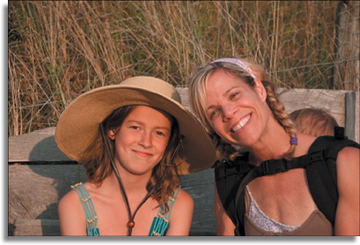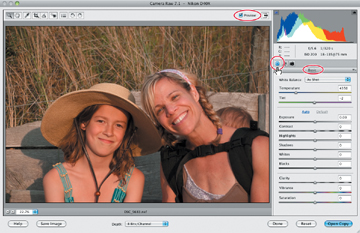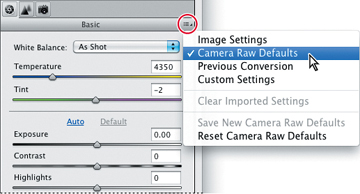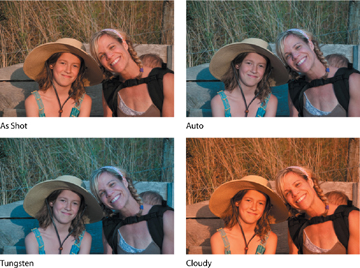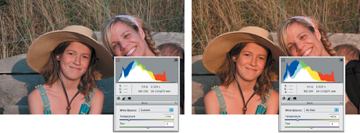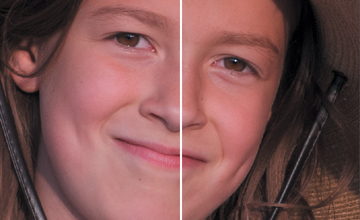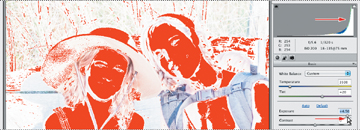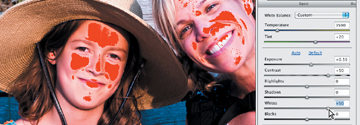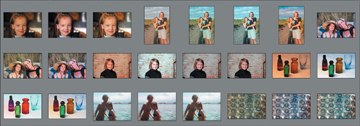- Getting started
- Editing photos in the Organizer
- Recognizing what your photo needs
- Making easy color and lighting adjustments
- Correcting photos in Quick Edit mode
- Adjusting images in Guided Edit mode
- Selective editing with the Smart Brush
- Working with camera raw images
- Review questions
- Review answers
Working with camera raw images
For the rest of this lesson you’ll be working with a raw image in Nikon’s NEF format as you explore the correction and adjustment controls in the Camera Raw window.
In the Organizer, click the arrow beside the Lesson 04 keyword tag to isolate the Lesson 4 images, if necessary. In the Media Browser, locate the camera raw image DSC_5683.NEF. Right-click / Control-click the thumbnail and choose Edit With Photoshop Elements Editor from the context menu. Photoshop Elements opens the image in the Camera Raw window.
The moment you open a camera raw file for the first time, the Camera Raw plug-in creates what is sometimes referred to as a sidecar file in the same folder as the raw image file. The sidecar file takes the name of the raw file, with the extension “.xmp.” Any modification that you make to the raw photograph is written to the XMP (Extensible Metadata Platform) file, rather than to the image file itself, which means that the original image data remains intact, while the XMP file records every edit.
- Use the Windows System Tray (XP), the Notification Area (Vista), or the Dock on Mac OS to switch back to the Elements Organizer. In the My Folders list in the left panel, right-click / Control-click the Lesson04 folder and choose Reveal In Finder from the menu. A Windows Explorer or Mac OS Finder window opens to show the contents of your Lesson04 folder. The new XMP sidecar file, DSC_5683.xmp, is listed beside the NEF image file.
- Return to the Editor—and the Camera Raw window—in Photoshop Elements.
This section will not only familiarize you with the unique characteristics of raw image files, but an exploration of the Camera Raw window will also serve as a review of the image editing concepts and terminology you learned earlier.
Getting to know the Camera Raw window
On the right side of the Camera Raw window is a control panel headed by three tabs: Basic, Detail, and Camera Calibration. For this set of exercises you’ll work with the Basic tab—the default—which presents controls for making adjustments that are not possible with the standard editing tools in Photoshop Elements.
Make sure that the Preview checkbox above the image window is activated.
- Hold the pointer over each tool in the toolbar to see a tooltip with the name of the tool and the respective keyboard shortcut. Click the Toggle Full Screen Mode button (
 ) at the right of the tool bar to switch to full screen mode.
) at the right of the tool bar to switch to full screen mode. Click the menu icon at the right of the Basic tab’s header bar to see the choices available from the control panel Options menu. You can apply the same settings you used for the last image you worked with, have Photoshop Elements revert to the default Camera Raw profile for your camera by choosing Reset Camera Raw Defaults, or save your own custom settings as the new default for the camera that captured this image.
Adjusting the white balance
The Camera Raw white balance presets can be helpful when you need to rectify a color cast caused by incorrect camera settings or poor lighting conditions. If your camera was not correctly set up to deal with overcast conditions, for example, you could correct your image by choosing the Cloudy preset from the White Balance menu. Other presets help you to compensate for the deficient color balance caused by different types of artificial lighting. Incandescent lighting typically causes an orange-yellow color cast; fluorescent lighting is notorious for a dull greenish tint.
The As Shot setting reads the embedded metadata that records the camera settings when the image was captured, while the Auto setting recalculates the white balance based on an analysis of the image data.
Experiment with some of the presets available in the White Balance menu. Switch the setting back and forth to compare the Auto, Cloudy, and Tungsten preset to the default As Shot setting. In the following pages you’ll discover why the appropriate white balance is so important to the overall look of the image.
For now, choose As Shot from the White Balance presets menu.
For many photos, the right white balance preset will produce satisfactory results, either used “as is,” or as a starting point for manual adjustment. When none of the presets seems to take your image in the right direction, you can use the White Balance tool (
 ) to sample a color from the photo to be used as a neutral reference in relation to which Camera Raw will recalculate the white balance.
) to sample a color from the photo to be used as a neutral reference in relation to which Camera Raw will recalculate the white balance.The ideal sample for this purpose is a light to medium gray that is neither discernibly warm or cool in tone. In our sample photo, the weathered wood is a potential reference, but we can probably be more certain that the steel fencing wire in the background is a neutral gray.
- Zoom into the image by choosing 100% from the Zoom Level menu in the lower left corner of the image window, or by double-clicking the zoom tool. Select the Hand tool (
 ) and drag the image downwards and to the right so that you can see the thick wire to the left of the girl’s hat.
) and drag the image downwards and to the right so that you can see the thick wire to the left of the girl’s hat. Select the White Balance tool (
 ), right beside the Hand tool in the tool bar. Sample a medium gray from the center of the wire where it crosses a relatively dark area. If you see little effect, click a slightly different point.
), right beside the Hand tool in the tool bar. Sample a medium gray from the center of the wire where it crosses a relatively dark area. If you see little effect, click a slightly different point.Zoom out by choosing Fit In View from the Zoom Level menu in the lower left corner of the preview window.
The White Balance is now set to Custom and the image has become cooler. The weathered wood in the background is a more neutral gray and the skin tones are rosier. The eyes also look clearer, having lost the original yellow-orange cast.
- Use the White Balance menu to alternate between your custom settings and the As Shot preset, noting the change in the preview window, as well as the differences in the Temperature and Tint settings.
Working with the Temperature and Tint settings
The White Balance tool can accurately remove any color cast or tint from an image but you may still want to tweak the Temperature and Tint settings. In this case, the color temperature seems fine, but the girl’s skin still has a slightly sallow look that can be corrected by fine-tuning the green/magenta balance using the Tint control.
- Use the Zoom tool or the Zoom Level menu in the lower left corner of the preview window to focus closely on the girl’s face.
Increase the Tint setting to +20 with the slider or type +20 in the Tint text box. Press Ctrl+Z / Command+Z to toggle between the new Tint setting and the value set with the White Balance tool, comparing the effect.
- Double-click the Hand tool or by choose Fit In View from the Zoom Level menu. Now that the tint has been adjusted towards magenta, the corrected temperature of the image appears just a little warm.
- Test the Temperature slider by dragging it from one end of its range to the other. You’ll see that the colors of the image become cooler or warmer as you move the slider. Reset the Temperature control a little below the edited value of 3800 either by dragging the slider or typing the value 3500 into the text box.
Working with color can be very subjective; depending on the subject matter and the effect you wish to achieve, there are times when you might choose to retain a slight, controlled color cast. For example, although technically in need of correction, you might prefer the original overly warm cast in our lesson image (a result of late afternoon sunlight) for its evocative, summery look.
Most often used for fine color correction, the white balance settings can also be applied creatively to achieve surprising and dramatic atmospheric effects.
Using the tone controls on a raw image
The settings for tonal adjustments are located below the White Balance controls on the Basic tab. In this exercise, you’ll use these controls to correct exposure, check highlights and shadows, and adjust brightness, contrast, and saturation. Before you adjust any of the settings, you should understand what each of the controls does:
Exposure adjusts the lightness or darkness of an image. Its effect is most apparent through the middle of the histogram; when you increase the Exposure setting, the main body of the curve will move to the right, compressing the highlights as much as possible rather than shifting them off the end of the curve. Use the Exposure control to lighten and brighten a dull, underexposed photo or correct the flat, faded look of an image that’s overexposed.
Contrast is the amount of difference in brightness between the lightest and darkest areas of an image. The Contrast control has the most noticeable effect at the ends of the histogram; increasing the setting will move information outwards from the center of the curve. Use Contrast to add definition to a photo that appears flat or washed out, or to soften an image that is too harsh or stark.
Highlights recovers details from overexposed highlights and lifts the midtone range. The Recovery control can reconstruct some detail in areas where one or two color channels have been clipped to white.
Shadows recovers details from shadows, without brightening blacks—something close to the inverse of the action of the Highlights control, reconstructing detail in areas where one or two of the color channels have been clipped to black, and adding depth to the midtone range.
Whites specifies which input levels are mapped to white in the final image. Lowering the whites value decreases clipping at the right end of the histogram. Clipping occurs when a pixel’s color values are higher or lower than the range that can be represented in the image; over-bright values are clipped to output white, and over-dark values are clipped to output black.
Blacks specifies which input levels are mapped to black in the final image. Lowering the Blacks value expands the areas that are mapped to black; raising it decreases clipping at the left end of the histogram.
Clarity increases the local contrast between adjacent light and dark areas, sharpening detail without producing halo effects and enhancing the midtone contrast.
Vibrance adjusts the saturation so that clipping is minimized as colors approach full saturation, acting on all lower saturated colors but having less impact on higher saturated colors. Vibrance also prevents skin tones from becoming oversaturated.
Saturation is the purity, or strength, of a color. A fully saturated color contains no gray. The Saturation control makes colors more vivid (containing less black or white) or more muted (containing more black or white).
First you’ll adjust the overall exposure and contrast; then, set the white and black points to avoid clipping at the ends of the histogram before tweaking the highlights and shadows to bring out as much image detail as you can.
Press the letter O on your keyboard to activate the white clipping warning; then, keep an eye on the histogram as you drag the Exposure slider slowly all the way to the right. The red areas that appear in the preview warn you which parts of the image are being clipped to white.
- Drag the slider to the left until all the red areas disappear—even from the woman’s head-band;. The Exposure control doesn’t cause white clipping until the setting is extreme; for now, set the Exposure value to +0.5.
Watch the histogram as you drag the Contrast slider through its full range, before setting it to a value of +50.
Put the Whites slider through its paces. White clipping is already beginning to appear when the setting reaches +10. Return the Whites to a zero setting.
Press U on your keyboard to activate the black clipping warning, and then play with the Blacks slider. Set the Blacks to -10—the point below which the blue clipping warning appears in the darkest areas of the image.
- Move the Highlights slider all the way to the right. Although the effect on the image is quite extreme, there is no clipping now that you’ve set the white point. Watch the textural detail reappear in the sunlit wood as you reduce the Highlights setting to -50. Drag the Shadows slider to set a value of +50, watching as detail is retrieved from the darkest areas in the photo. Press the U and O keys on your keyboard to disable the clipping warnings.
Choose a magnification level of 100% from the Zoom menu at the lower left of the image window, or double-click the Zoom tool. Use the Hand tool to center your view on the girl’s face; then, drag the Clarity slider to +50. Double-click the Hand tool to see the entire image, and then set the Vibrance value to +25.
To compare the adjusted photo to the raw image, toggle the Preview check box at the right of the tool bar above the preview.
The photo originally looked somewhat dull, muddy, and indistinct, and a little too dark. It now shows a broader range of detail and is more vivid; the colors are brighter and the tones are more realistic. For the sake of clarity in our demonstration however, some of the adjustments you made were quite extreme. If you wish to tone down the corrections to balance the image to your taste, you can do so now.
Saving the image in the DNG format
Each camera manufacturer has its own proprietary raw format, and not every raw file can be read or edited by software other than that provided with the camera. There is also the possibility that manufacturers might not support every format indefinitely. To help alleviate these problems, Photoshop Elements gives you the option to save raw images in the DNG format, a publicly available archival format for raw images that provides an open standard for files created by different camera models, ensuring that you’ll still be able to access your images in the future.
- To convert and save the image, click the Save Image button at the lower left of the Camera Raw dialog box. Under Destination in the Save Options dialog box, click Select Folder. Navigate to and open your Lessons folder; then, highlight your My CIB Work folder and click Select.
- Under File Naming, leave Document Name selected in the menu on the left. Click the menu on the right and select 1 Digit Serial Number. This will add the number 1 to the end of the file name.
- Click Save. The file, together with all your current settings, will be saved in DNG format, which you can reprocess repeatedly without losing the original data.
- Click the Open Image button in the right lower corner of the Camera Raw dialog box. Your image will open in a regular image window in Photoshop Elements. Choose File > Save. Navigate to your My CIB Work folder, name the file DSC_5683_Work, and choose the Photoshop format. Make sure that the new file will be included in the Organizer, but not in a Version Set.
- Click Save, and then choose File > Close.
Congratulations! You’ve completed the lesson; take a look in the Media Browser to see how much you’ve learned.
Before you move on, take a moment to read through the review on the facing page.
